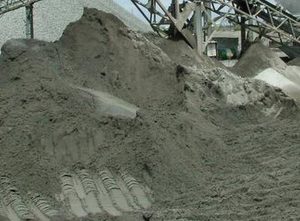Ijraset Journal For Research in Applied Science and Engineering Technology
- Home / Ijraset
- On This Page
- Abstract
- Introduction
- Conclusion
- References
- Copyright
A Comparative Study on the Mechanical Properties of Concrete Using M-Sand and Ground Nut Shell Ash as a Partial Replacement of River Sand
Authors: Susmitha Alluboina, Ramesh Bandaru, Mahesh Dangeti
DOI Link: https://doi.org/10.22214/ijraset.2022.47732
Certificate: View Certificate
Abstract
Now a days the global consumption of sand as quality aggregate in concrete production could be very excessive. Several growing nations have encountered some strain within the supply of herbal sand as a way to meet the growing need of the infrastructural development in latest 12 months, to conquer the strain and call for of river sand, researchers and practitioners inside the creation enterprise have identified a few opportunity. One of them is M-sand; it is high pleasant silica sand with uniform bodily traits and with the aid of made from crushing of granite rocks. It is proved that M-sand used, as quality combination will decorate the electricity of concrete to a greater extend. This paper presents an experimental research at the homes of concrete in which satisfactory mixture is partially changing by using used M-sand and Ground nut shell ash. The most effective variable considered on this study is volumetric substitute (10%, 20%, 30%, forty%, and 50%) of sand. Out of those 5 substitute levels satisfactory 3 were pick by using trial works. The concrete become tested for droop test, compression test, flexural check, split tensile test for 7 & 28 days.
Introduction
I. INTRODUCTION
Concrete can be a usually used composite production material. It is economical due to the fact substances of concrete are without difficulty available. Inside the creation of homes and different systems concrete performs the rightful function where a large quantum of concrete is being applied. The proportionate amount of every fabric influences the homes of hardened concrete. Thanks to various environmental issues and the want for power conservation, various research works are directed toward the usage of various waste materials. Quality research work has been presented in previous couple of many years on use of waste materials, together with; rubber tires ,glass powder , marble powder in concrete as a alternative of fine and coarse aggregate to supply low cost and surroundings friendly concrete. These wastes require special treatment to be used as alternative of fine combination in concrete. Numerous waste materials are generated from manufacturing methods, service industries and municipal stable wastes.
The increasing recognition approximately the surroundings has enormously contributed to the worries associated with disposal of the generated wastes. The recycling of waste from creation substances implies a huge discount in amounts, destined to disposal by means of land filling, which boosts the achievement of recycling fees set up through regulation, consequences in a reduction within the use of non-renewable sources and produces a high-quality outcome on surroundings. Additionally, in numerous locations, traditional building materials may also persuade be too steeply-priced and inadequate to face the worldwide developing need for housing development. Accordingly, the utilization of waste as opportunity material may additionally assist to satisfy the above shortages.
A. Manufactured sand (M-SAND)
M-sand is an additional of river sand for concrete systems. Manufactured sand is created as rigid granite stone by way of crushing. The overwhelmed sand is of cubical shape with grounded barriers, washed and categorised as a building material. The volume of manufactured sand (M-Sand) is a discounted quantity of 4.Seventy five mm. M-Sand is synthetic sand made of crushing hard gravel into minor sand-sized angular molded gadgets, wash away as well as excellently graded for use as building aggregate. It is a extra alternative for River Sand for building functions. Manufactured Sand (M-sand) is the utmost mutual alternative of river sand, which has previously delivered significance in about of the southern States.
It is synthetic by way of crushing of rocks, quarry stones to a required length of one hundred fifty microns. To attain the vital grain length, gift rougher tough rock deposits are crushed in a chain of crushers and the crushed material is separated into distinct quantities as appropriate to several constructing movements.
Fig 1.1process of manufacturing sand
B. Groundnut Shell Flyash
Groundnut is a nutritious leguminous yield, filled specifically for seed and oil worldwide. Groundnut shells are the extra item gotten after the end of groundnut seed from its case. This is the copious agro-business side-effect which has an absolutely slow debasement cost under natural condition. Be that as it may, Groundnut shells contain different bioactive and viable added substances which are bene?cial for humanity. Monetarily, it's miles utilized as a feedstock, food, ?ller in manure or even in bio-?lter merchants. However, limit of the abandoned groundnut shells are scorched or covered resulting in ecological contamination.
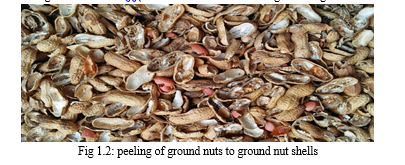
C. Utilization of Groundnut Shells as Building Material
Groundnut shell debris can be utilized as folio in sandcrete blocks (1:eight proportion) with respect to solidify substitution. The residue content, speci?c gravity, the hunch and compressive strength of groundnut shell debris and have been inspected. The groundnut shell debris might be utilized as a halfway option of concrete in sandcrete block to get an extraordinary compressive energy at roughly 20% of the folio sum. Groundnut shell constituent material transformed into used in concrete for the fractional substitution of ?ne combination (waterway sand). Actual homes of concrete, groundnut shell and totals not entirely set in stone.
The usefulness of clean cement become decided fundamentally based at the e?ect of groundnut shells by utilizing hang and compacting part expense investigate and the compressive strength and thickness upsides of the 3D shapes likewise imagined. The results inferred that the groundnut shell might be e?ciently utilized for the assembling of gentle weight concrete.
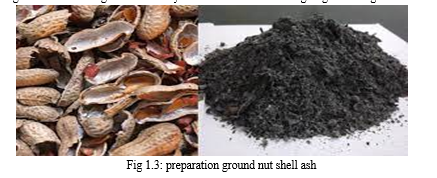
II. MATERIALS AND METHODS
A. Assortments of Materials
- Concrete: OPC 53 Nagarjuna concrete is utilized in this task.
- Fine Total: The sand utilized for our examination is gathered structure Godavari stream sand which is adjusting to Zone III according to Indian Determination 383-1970 codal arrangements.
- Coarse Total: the coarse total of max20mm size with a rakish shape which is all around evaluated.
- Producing Sand: It is gathered from Srilatha prepares Endeavors in B N Reddy Nagar settlement, Hyderabad, Telangana .
- Ground Nutshell fly Ash: locally accessible ground nuts are gathered and ground nutshell debris is ready by a result of controlled consuming of groundnut shells.
???????B. Deciding the Actual Properties Of Materials
- Concrete: Standard Portland concrete is utilized for general developments. The unrefined components expected for production of Portland concrete are calcareous materials, for example, limestone or chalk and argillaceous materials like shale or mud. The production of concrete comprises of crushing the unrefined components, blending them personally in specific extents relying on their immaculateness and sythesis and consuming them in an oven at a temperature of around 13000C to 15000C at which temperature, the material sinters and somewhat breakers to frame nodular formed clinker. The clinker is cooled and ground to a fine powder with expansion of around 2 to 3% of gypsum. The item framed by utilizing the technique is a "Portland cement". The following tests according to IS: 4031-1988 is finished to discover the actual properties of the concrete. The aftereffects of the tests are contrasted with the predefined upsides of IS: 4031-1988.
- Consistency: The standard consistency of concrete glue is characterized as consistency, which will allow the Vicat unclogger to infiltrate to a point 5-7 mm from the lower part of the shape, this test is finished to decide the amount of water expected to create concrete glue of standard consistency. For deciding the setting time, compressive strength and adequacy, the level of water expected to create concrete glue of ordinary consistency is utilized. Consistency relies on the piece of concrete, this test was led according to the strategy given in IS: 4031-1988. The consistency esteem got is displayed in table.
- Starting and Last Setting Time: Bring down the needle tenderly and get it contact with the outer layer of the test block and immediately discharge. Permit it to infiltrate into the test block. In the first place, the needle will totally puncture through the test block. Yet, after some time when the glue begins losing its pliancy, the needle might infiltrate just to a profundity of 33-35mm from the top. The period slipping by between the times when water is added to the concrete at the hour of which the needle infiltrates the test block to a profundity equivalent to 33-35mm from the top is taken as starting setting time. Supplant the needle of the Vicat device by a round connection. The concrete will be considered as at last set while, bringing down the connection delicately cover the outer layer of the test block, the middle needle establishes a connection, while the roundabout edge of the connection neglects to do as such. At the end of the day the glue has accomplished such hardness that the middle needle doesn't puncture through the glue more than 0.5mm.
Table -3.1 cement physical properties
|
Properties |
Results |
Permissible limits as per IS:12269-1987 |
|
Fineness of cement |
OPC 53 – 6% OPC 53 S -1% |
Shall not be less than 10 % |
|
Normal consistency |
32 |
- |
|
Specific gravity |
3.15 |
- |
|
Setting time Initial Final |
40 mints 330mints |
Should not be less than 30 min Should not be more than 600 min |
|
Soundness of cement |
2mm |
|
|
Compressive Strength of Cement Motor cubes for 3 days 7 days 28 days |
29 37.83 53.6 |
Should not be less than 23 N/mm2 Should not be less than 33 N/mm2 Should not be less than 43 N/mm2 |
Table-3.2 physical properties of OPC-53grade cement
|
PROPERTITES |
OPC 53 |
|
Fineness of cement |
8% |
|
Standard consistency |
32% |
|
Specific gravity |
3.15 |
|
Initial setting time |
40 minute |
|
Final setting time |
330 minute |
|
Soundness |
2mm |
Table-3.3 compressive strengths of OPC 53 grade cement
|
S.No |
OPC 53 in N/mm2 |
||
|
7 days |
14 days |
28 days |
|
|
1 |
29.5 |
38.8 |
54.2 |
|
2 |
28.5 |
37.2 |
53.8 |
|
3 |
29 |
37.5 |
53 |
|
average |
29 |
37.83 |
53.67 |
???????C. Totals
Totals are the significant constituents in concrete. They give body to the substantial, lessen shrinkage and impact economy. Totals possess 70 to 80 percent of volume of cement. Totals are acquired either normally or falsely. Totals can be grouped based on size as fine total and coarse total, Fine total (sand)
Table-3.4: fine aggregate sieve analysis
|
Size of sieve
|
Retained Weight (g) |
Retained Total Weight (g) |
Retained% Cumulative Weight |
% Passing through |
Fineness Modulus |
Grading Zone as per Indian Standard 383-1970 |
|
4.75mm475m4m |
0.013 |
0.013 |
1.3 |
98.7 |
2.2 |
Zone-III |
|
2.36 |
0.019 |
0.032 |
3.2 |
96.8 |
||
|
1.18 |
0.046 |
0.078 |
7.8 |
92.2 |
||
|
600µ |
0.238 |
0.316 |
31.6 |
68.4 |
||
|
300µ |
0.518 |
0.834 |
83.4 |
16.6 |
||
|
150µ |
0.122 |
0.956 |
95.6 |
4.4 |
||
|
pan |
0.044 |
1 |
100 |
0 |
- Result
Fineness modulus of fine aggregate = (∑cumulative % weight retained)/100 = 222.9/100 = 2.2
The given sand belongs to ZONE-III and Coarse Sand
2. Specific Gravity
The specific gravity of fine aggregate is determined by using pycnometer
Specific gravity of fine aggregate of the given by empirical formula

3. Bulk Density
The bulk density of the fine aggregate for the given sample is 1.690kgs/ Lit
Table -3.5 physical properties of fine aggregate:
|
Properties |
Test results |
|
Specific gravity |
2.52 |
|
Fineness modulus |
2.2 |
|
Bulk density |
1.69 |
4. Coarse Total: The coarse total utilized is from deep rooted quarry, it IS 383:1970 to fulfill the code. The combination of coarse totals is utilized of just 20 mm .the material is of uniform tone and has great rakish shape. The actual properties like fineness-modulus, explicit gravity mass thickness, water-ingestion, total effect, and pounding esteem.
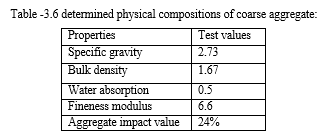
5. Assembling SAND: Foundry squander in present work is gotten from Bhavani castings a foundry industry in Kakinada. Foundry sand here is a to some extent reused material and reused through numerous creation cycles, after commonly it loses its qualities particularly the tidiness and the consistency ones. In this manner in the wake of losing its unique qualities it becomes unacceptable in the assembling system and is disposed of as waste.
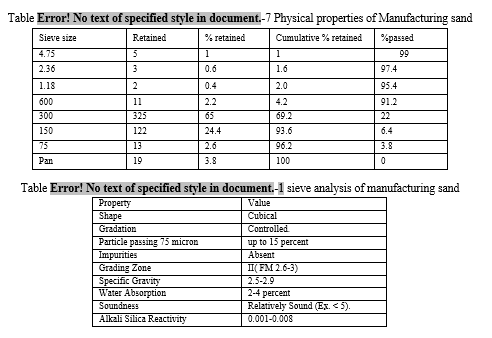
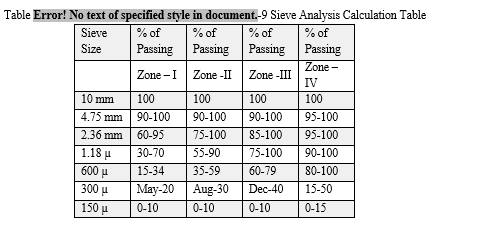
6. Ground Nut Shell Ash
It is collected from passing the sieve 1.18mm
3.10 Physical properties of Ground nut shell ash
|
PHYSICAL PROPERTIES |
RESULTS OBTAINEDGROUND NUT SHELL ASH |
|
Specific Gravity |
1.54 |
|
Fineness Modulus |
1.51 |
|
Moisture content |
0.42 |
7. Blending
The object of blending is to cover the outer layer of all total particles with Concrete glue and to mix every one of the elements of cement into a uniform mass. However blending of the materials is fundamental for the creation uniform cement. The blending ought to guarantee that the mass becomes homogeneous, uniform in variety and consistency. In this study the course of hand blending was embraced.
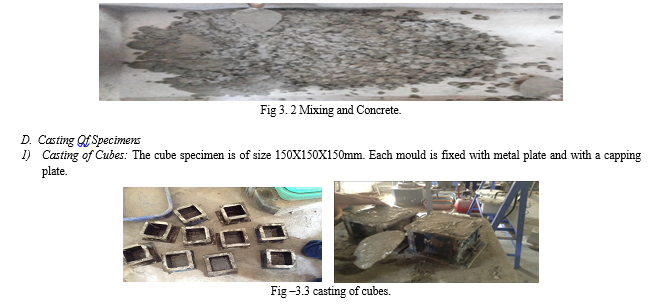
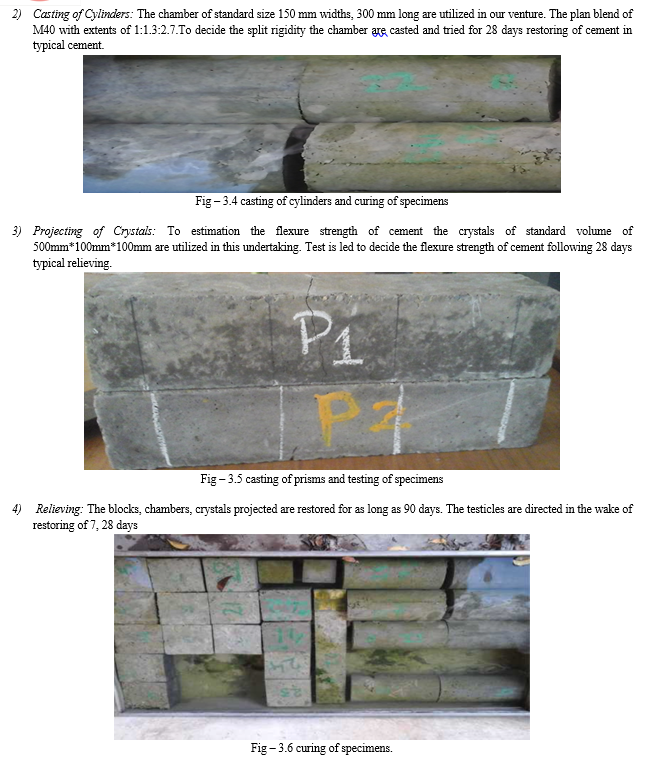
III. RESULTS AND DISCUSSIONS
A. Fresh Concrete
The test conducted on fresh concrete is workability of the concrete.
- Workability: Workability is defined as the ability of the fresh concrete to fill the mold under proper vibration without reducing the quality. Properties which influence workability are water content, aggregate, cement type, age of concrete and admixtures. Workability increases with increase in water content i.e. more water content results in bleeding and segregation of concrete mix which in turn results in the strength reduction. Chemical admixtures also increase the workability. Concrete mix from undeniable graded aggregate results in harsh mix having low slump which in turn results in low workability.
a. Slump cone
b. Compacting factor
c. Vee- bee test
In this project to determine the workability the slump cone test is conducted. By having the result we can conclude the slump is true slump, shear slump moderate slump.
The slump values for different mix proportions are given in the table
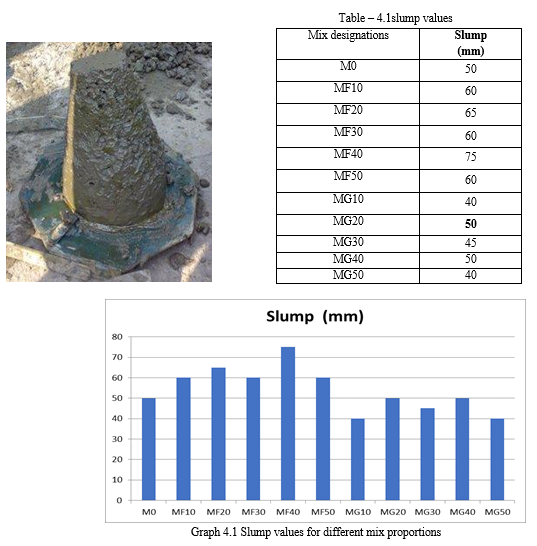
In figure, 4.2 shows that control blend (M0) give the rut worth of 50. Blends of MF10, MF 20, MF30, MF 40, MF 50 were give higher rut than control blend. Blends MG10, MG 20, MG30, MG 40, MG 50 were give lesser than or equivalent rut upsides of control blend.This implies supplanting of Assembling sand with fine total gives great usefulness conditions contrasted with control blend and ground nutshell debris supplanted concrete. Comparatively substitution of ground nutshell debris with fine total gives lesser usefulness than control blend and M-sand supplanted concrete.
???????B. Compressive Strength
Following 28 days of restoring the example shapes are tried for compressive strength under compressive testing machine. The test tests are taken out from restoring tank somewhere around 4 to 5 hours of testing. For one path something like three examples are to be tried.
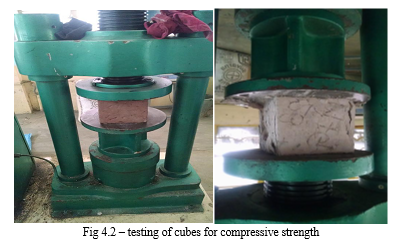
The cube is placed under the compressive testing machine in a way that the load should be applied opposite faces of the other than the casted faces. The load is applied on the cube continuously at the rate of 140kg/cm2/min. the load is applied till the load break down and no more load can be taken i.e. the red needle returns back.
The ultimate load is noted. The compressive strength is determined by dividing the ultimate strength by cube cross sectional area. Similarly the remaining two specimens are also tested. The average of the three specimens of one particular batch of mix gives the compressive strength. The variation of the strength of individual strength should not exceed more than 15%. If exceeded repeat the test.
???????C. Test for split Tensile Strngth
The specimens are tested for tensile strength for 28 days on split tensile testing machine. Specimen, preferably from different batches, should batches, should be made for testing for each selected age, specimen are removed from water before 4 to 5 hours of testing.
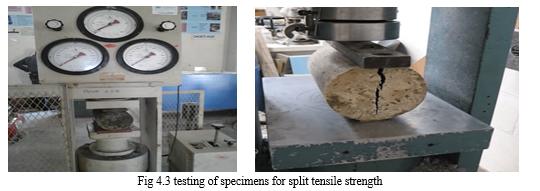
Where as in cylinders they are placed under the compressing testing machine in a way that the load is applied along the length of the cylinder. Continuous load at the rate of 140 kg/cm2/min is applied till the maximum resisting load is attained, i.e. the red needle returns back. The ultimate load is noted. Split tensile strength of the specimen is calculated by diving the two times of the load during the test by dividing the two times of the load during the test by the surface area, calculated from the mean dimensions of the section. For one particular batch the average of the specimen are to be done. The average of the three specimens of one particular batch of mix gives the compressive strength. The variation of the strength of individual strength should not exceed more than 15%. If exceeded repeat the test.
???????D. Test for Flexural Strength
Flexural strength of the concrete is done using the universal testing machine. The bearing surface of the supporting and loading rollers of the machine should be cleaned. The prism should be placed under the rollers in such a way that the load is applied on the uppermost surface of the casted mould. The prism should be marked at the spacing of 13.3cms a part.

???????E. Compressive Strength
Result representing the compressive strength values from 7days,14 days and 28 days at various replacement levels i.e. at 0 % to 50 % replacement of M-Sand & Ground nut shell ash in Fine aggregate
By considering the M 30 mix proportions the different mix are casted the mix details are shown the table
Mix methodology table:
Table – 5.1mix proportions for 1 m3
|
Mix designations |
Cement content |
F.A content |
C.A content |
M-Sand |
Ground nut shell ash (GNSA) |
Water |
|
M0 |
437.77 |
774.54 |
983.07 |
0 |
0 |
197 |
|
MF10 |
437.77 |
697.05 |
983.07 |
77.45 |
0 |
197 |
|
MF20 |
437.77 |
619.24 |
983.07 |
154.91 |
0 |
197 |
|
MF30 |
437.77 |
542.18 |
983.07 |
232.36 |
0 |
197 |
|
MF40 |
437.77 |
464.72 |
983.07 |
309.82 |
0 |
197 |
|
MF50 |
437.77 |
387.27 |
983.07 |
387.27 |
0 |
197 |
|
MG10 |
437.77 |
697.05 |
983.07 |
0 |
77.45 |
197 |
|
MG20 |
437.77 |
619.24 |
983.07 |
0 |
154.91 |
197 |
|
MG30 |
437.77 |
542.18 |
983.07 |
0 |
232.36 |
197 |
|
MG40 |
437.77 |
464.72 |
983.07 |
0 |
309.82 |
197 |
|
MG50 |
437.77 |
387.27 |
983.07 |
0 |
387.27 |
197 |
Note : M0is the conventional concrete, MF10 is the 10% of Fine aggregate Replacement with M-sand, MF20 is the 20% replacement of Fine aggregate with M-sand, MF30 is the 30% of Fine aggregate Replacement with M-sand, MF40 is the 40% replacement of Fine aggregate with M-sand, MF50 is the 50% of Fine aggregate Replacement with M-sand, MG10 is the 10% replacement of Fine aggregate with Groundnut shell ash(GNSA), MG20 is the 20% replacement of Fine aggregate with GNSA MG30 is the 30% replacement of Fine aggregate with GNSA, MG40 is the 40% replacement of Fine aggregate with GNSA, MG50 is the 50% replacement of Fine aggregate with GNSA.
Table -5.2 compressive strength Results
|
MIX DESINATION |
Compressive strength N/mm2 |
|||
|
7 days |
14 days |
28 days |
||
|
M0 |
21.05 |
28.41 |
31.56 |
|
|
MF10 |
18.89 |
25.49 |
28.32 |
|
|
MF20 |
18.48 |
24.93 |
27.68 |
|
|
MF30 |
19.05 |
25.71 |
28.56 |
|
|
MF40 |
19.56 |
22.12 |
29.32 |
|
|
MF50 |
16.39 |
19.16 |
24.56 |
|
|
MG10 |
16.36 |
22.09 |
24.53 |
|
|
MG20 |
17.66 |
23.82 |
26.46 |
|
|
MG30 |
18.6 |
25.08 |
27.87 |
|
|
MG40 |
20.3 |
27.38 |
30.42 |
|
|
MG50 |
19.05 |
25.68 |
28.53 |
|
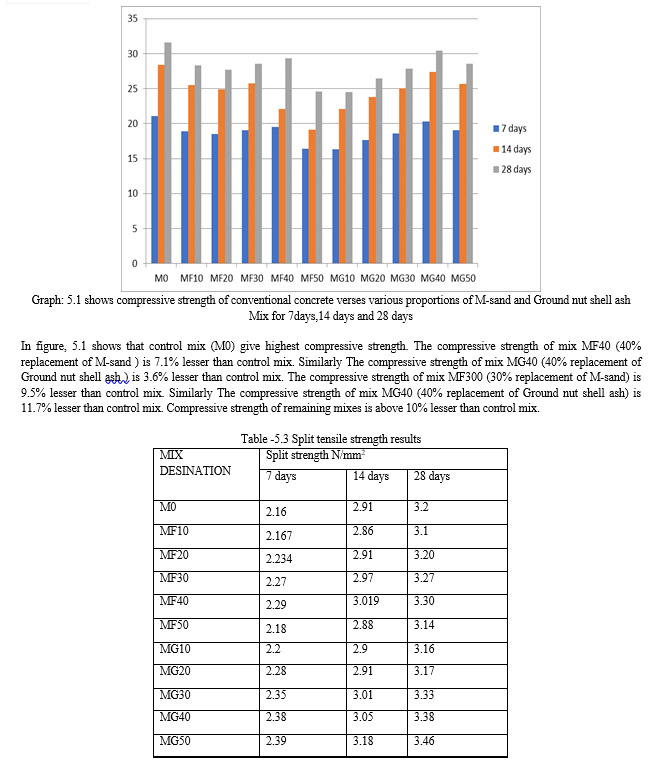
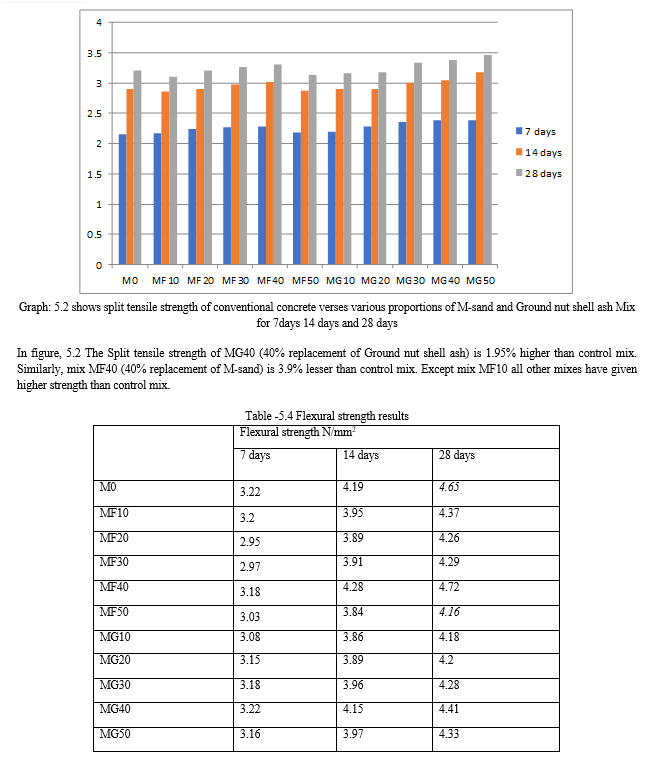
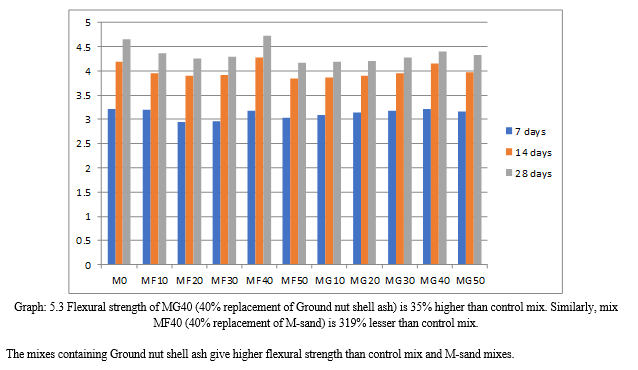
IV. FUTURE SCOPE
The grade of concrete used in our experimental study is M30, may be this M-sand can also be used as replacing material for fine aggregate in high strength concrete works.
- For light weight and self-compacting concrete works M-sand may also used as replacing material for fine aggregate.
- Not only compressive strength test various tests like split tensile strength, flexural strength, modulus of elasticity etc., may also be conducted.
- Not only mechanical properties durability tests also conducted.
Conclusion
From our research it is concluded that, 1) Waste M-sand and Ground nut shell ash can be effectively used as fine aggregate in concrete. 2) Replacement of fine aggregate with M-sand and Ground nut shell ash gives optimum strength at 40% replacement then there was a marginal decrease in the strength. 3) At 40% replacement of sand gives maximum strength at the age of 28 days. 4) There is a compressive strength decrease of 7.12.% and 3.6% in 28 day curing for mix MF40 and MG40 respectively than conventional concrete. 5) There is a split tensile strength increase of 3.12% and 5.62 % in 28 day curing for mix MF40 and MG40 respectively than conventional concrete. 6) There is a Flexural strength increase of 1.5% with glass waste and 5.16% decrease at 28 day curing for than conventional concrete. 7) When compared to M-sand replacement of sand Ground nut shell ash replacement of sand give better results. 8) It gives the environment friendly concrete. it helps in preparing green concrete.
References
[1] A.seeni, dr.c.selvamony, dr.s.u.kannan, dr.m.s.ravikumar “experimental study of partial replacement of fine aggregate with waste material from china clay industries” International Journal Of Computational Engineering Research (ijceronline.com) Vol. 2 Issue.8.dec-2012,p-p-167-171. v : 2 2277 – [2] Amitkumar D. Raval, Arti Pamnani, Alefiya I. Kachwala “foundry sand: utilization as a partial replacement of fine aggregate for establishing sustainable concrete” international journal of engineering sciences & research technology [raval, 4(1): january, 2015] Issn: 2277-9655 p-p- 308-311. [3] Amitkumar d. raval, dr. Indrajit N. patel, Arti pamnani, Alefiya I and Kachwala effect of waste foundry sand as partial replacement of sand in concrete international journal of advance engineering and research development volume 2,issue 1, january -2015,p-p-19-22. [4] D. pradeep kumar, dr. p. eswaramoorthi, basil baby “strength characteristics of structural concrete elements using foundry sand” international journal of engineering research and applications (ijera) issn: 2248-9622 trends and recent advances in civil engineering (trace- 24th-25th january 2014),p-p-64-68. [5] Dushyant R. Bhimani Jayeshkumar Pitroda Jaydevbhai J. Bhavsar “A Study on Foundry Sand: Opportunities for Sustainable and Economical Concrete”volume-2, issue-1, jan-2013,issn no-2277-8160,p-p-60-63. [6] Dushyant R. Bhimani, Jayeshkumar Pitroda, Jaydev J. Bhavsar “ innovative ideas for manufacturing of the green concrete by utilizing the used foundry sand and pozzocrete” International Journal of Emerging Science and Engineering (IJESE) ISSN: 2319–6378, Volume-1, Issue-6, April 2013,p-p-28-32. [7] Dushyant Rameshbhai Bhimani, Jayeshkumar Pitroda Jaydevbhai J. Bhavsar “used foundry sand: opportunities for development of eco-friendly low cost concrete” International Journal of Advanced Engineering Technology Vol. IV/ Issue I/Jan.-March., 2013/63-66. [8] Eknath P .Salokhe, D.B.desai “ Application of foundry waste sand in manufacture of concrete” IOSR journal of mechanical and civil engineering (IOSR-JMCE) ISSN: 2278-1684, pp: 43-48 [9] Jagannathan saravanan, G. srinivasan and B. palani “strength properties of concrete incorporating foundry sand and ceramic aggregates” international seminar, innovation & valorization in civil engineering & construction materials : 1p-137. [10] Khuram rashid1, dr. muhammad akram tahir , sana nazir “evaluation of concrete compressive strength by incorporating used foundry sand”American Journal of Engineering Research (AJER) e-ISSN : 2320-0847 p-ISSN : 2320-0936 Volume-03, Issue-02, 2014,pp-109-116. [11] M. kacha, abhay v. nakum, ankur c. bhogayata use of used foundry sand in concrete: a state of art review international journal of research in engineering and technology eissn: 2319-1163 | pissn: 2321-7308. [12] M. RANJITHAM, B. PIRANESH, A. VENNILA “Experimental Investigation on High Performance Concrete with Partial Replacement of fine aggregate by Foundry Sand with cement by Mineral Admixtures” International Journal of Advanced Structures and Geotechnical Engineering ISSN 2319-5347, Vol. 03, No. 01, January 2014,p-p-28-33.
Copyright
Copyright © 2022 Susmitha Alluboina, Ramesh Bandaru, Mahesh Dangeti. This is an open access article distributed under the Creative Commons Attribution License, which permits unrestricted use, distribution, and reproduction in any medium, provided the original work is properly cited.

Download Paper
Paper Id : IJRASET47732
Publish Date : 2022-11-28
ISSN : 2321-9653
Publisher Name : IJRASET
DOI Link : Click Here
 Submit Paper Online
Submit Paper Online


